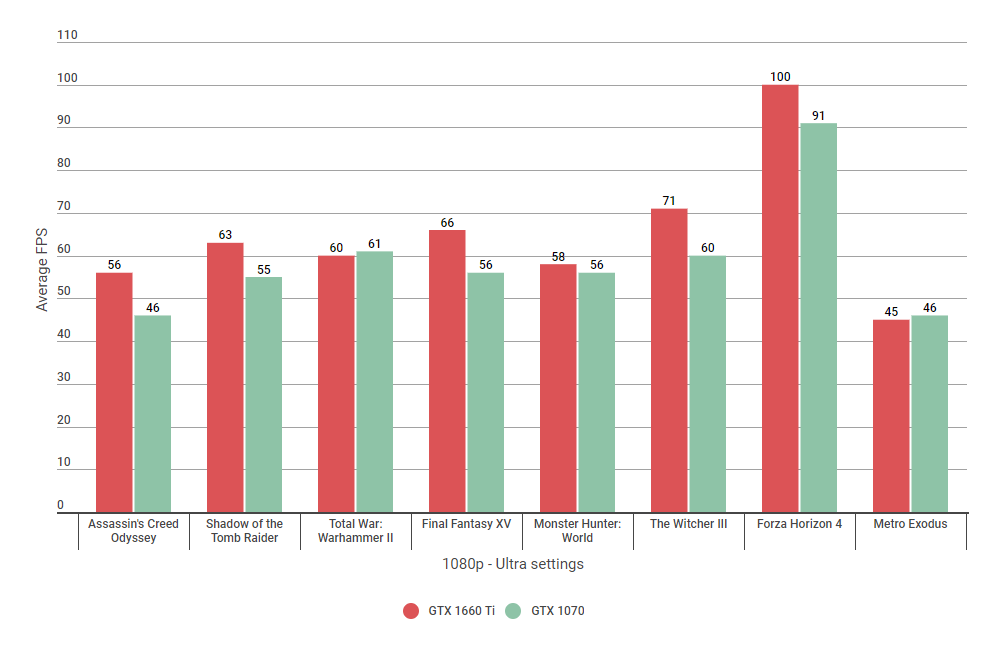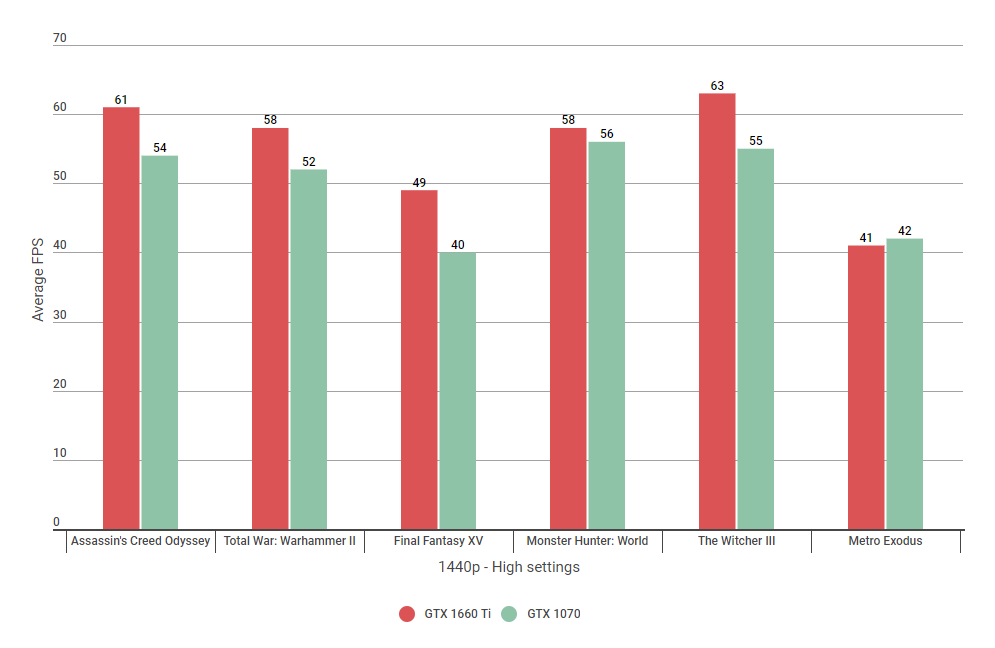Nvidia GTX 1660 Ti vs GTX 1070: Which graphics card is faster?
And which one should you buy?
I know it seems like I've been comparing the new Nvidia GeForce GTX 1660 Ti with practically every graphics card under the sun recently, including Nvidia's RTX 2060 and GTX 1060, but now it's time to take one final look at how it stacks up against its other main competition, the GTX 1070. Costing just a little bit more than the GTX 1660 Ti at time of writing, is there any hope at all that the GTX 1070 might still be worth buying? Let's find out with the help of some lovely graphs.
GTX 1660 Ti vs GTX 1070: How we test
Just like my GTX 1660 Ti vs GTX 1060 and GTX 1660 Ti vs RTX 2060 articles, I've tested each card with my general games benchmarking suite at 1920x1080 and 2560x1440 resolutions. That includes Assassin's Creed Odyssey, Shadow of the Tomb Raider, Final Fantasy XV (with Nvidia's fancy HairWorks, TurfEffects, VXAO and ShadowLibs effects turned off), Monster Hunter: World, The Witcher III, Forza Horizon 4, Total War: Warhammer II and Metro Exodus.
Paired with my Intel Core i5-8600K CPU and 16GB of Corsair Vengeance 2133MHz RAM, I've seen what each card can do on max settings at each resolution and taken an average frame rate (either from their own built-in benchmarks or from my own repeated manual gameplay tests) to see how they stack up against each other. In the case of 2560x1440 gameplay, I've also looked at what each one is capable on High quality settings, too.
And if you're wondering why the two graphics cards up the top there look exactly the same, that's because the cards in question are the Asus' ROG Strix GeForce GTX 1660 Ti OC and the Asus ROG Strix GeForce GTX 1070 Gaming, showing how little Asus' ROG Strix design has deviated over the years.
Both are some of the faster varieties of their respective cards out there, so the results below are probably more of a best-case scenario for what each one's capable of across the different resolutions and graphics settings, but I'm also confident that slower cards will be very much in the same sort of ballpark. After all, I've also been testing Asus' Phoenix GTX 1660 Ti card recently, and that's only an average of 2-5fps slower than the ROG Strix (and was more often just 2-3fps slower, too). As a result, I think you'll be perfectly able to apply most of the results below to the cheaper GTX 1660 Ti and GTX 1070 cards out there as well.
Now we've got all that preamble out of the way, let's dive into those lovely graphs, shall we?
GTX 1660 Ti vs GTX 1070: 1080p performance
On Ultra settings at 1920x1080, both cards are pretty much capable of delivering 60fps right off the bat in a variety of games. The GTX 1070 struggled with Assassin's Creed Odyssey's Ultra High settings a bit, and both had a tough time with Metro Exodus' turned up to eleven (see my Metro Exodus graphics performance guide for a full breakdown of what I consider 'Ultra' settings here), but on the whole you're looking at a smooth minimum of at least 55fps in most cases, making both cards perfectly suited to flawless 1080p play.
However, as you'll see from the number of taller red bars in the graph above, the GTX 1660 Ti has the upper hand in almost every game going, giving you a boost of around 10fps over the GTX 1070. There are, of course, a couple of games where the GTX 1070 claws back a bit of a lead, such as in Total War: Warhammer II and Metro Exodus, but even here you're talking about a boost of 1-2fps at best - which, to the naked eye, you're probably not going to notice.
Indeed, if it's a graphics card for a high refresh rate monitor you're after, then the GTX 1660 Ti is definitely the one to go for here as well, as it not only hits 60fps+ more frequently than the GTX 1070 at this resolution, but it can also do it on the best possible graphics setting, too, giving you the best looking games at faster frame rates.
GTX 1660 Ti vs GTX 1070: 1440p performance
Sticking with Ultra settings for a moment, we can see the GTX 1660 Ti is also the superior graphics card at 2560x1440 resolutions, too. Again, there are a couple of outlying cases where the GTX 1070 either catches up to the GTX 1660 Ti (Assassin's Creed Odyssey) or just edges it out by another single frame lead again (Metro Exodus), but the rest of the time the GTX 1660 Ti is the clear winner, offering as much as 20fps faster speeds than the GTX 1070.
It is, admittedly, a pretty close race most of the time. In Monster Hunter: World, for example, there's only an average of 4fps separating each card, and I doubt an average of 54fps in Shadow of the Tomb Raider with its basic SMAA anti-aliasing enabled will feel noticeably different to an average of 62fps. Still, the 8-10fps gap in Total War: Warhammer II and Final Fantasy XV are pretty significant, as far as I'm concerned, as I think almost everyone will agree that a low-40s frame rate is eminently more comfortable to play than something in the low 30s.
The same goes for playing games on High settings at 2560x1440 as well. As you'll see from the graph below, which mainly focuses on the games that didn't already result in scores of near-60fps back on Ultra, the GTX 1660 Ti once again takes the lead in practically every game going.
The only exception to that rule is, you guessed it, Metro Exodus, where the GTX 1070 was yet again a single frame in front. I should note that you can still get a smooth 60fps on both cards in this game with High quality enabled, but you'll need to turn off some of the other special effects in order to make it happen. Monster Hunter: World was also a pretty close call, averaging just 2fps faster with the GTX 1660 Ti, but elsewhere the GTX 1070 was a good 6-9fps behind.
Of course, an average frame rate in the low-to-mid 50s probably isn't going to be massively different in feel and overall smoothness to one in the high-50s-to-low-60s (at least compared to the low 30s vs low 40s gap on Ultra settings at this resolution), but there's no denying that the GTX 1660 Ti is a lot more capable of hitting a consistent 60fps here than the GTX 1070. As a result, if you want to be absolutely 100% sure you're getting 60fps and nothing less, then the GTX 1660 Ti is much more likely to deliver on that promise than its slightly aged relative.
GTX 1660 Ti vs GTX 1070: Conclusion
As you can see, it's a very closely run race between these two cards, but overall I think you'll agree that the GTX 1660 Ti is the superior card here. Not only is it more capable of hitting a consistent 60fps in practically every game on 1080p Ultra settings, but it's also the more reliable card if you're after 60fps on 1440p High as well.
The GTX 1070 still puts up a pretty good fight here and there, but when so many of its third party cards are more expensive than the £260 / $280 GTX 1660 Ti, it just doesn't make any sense to go for the GTX 1070 over its newer, cheaper sibling. If prices suddenly take a tumble below the GTX 1660 Ti, then there might be an argument for buying the GTX 1070 in order to save yourself a bit of cash for nearly-similarish sort of speeds, but really, I just don't think it's worth it, especially if you're after a card for playing games on decent quality settings at 2560x1440.
As a result, it's the GTX 1660 Ti that's my new best graphics card for 1080p gaming, as well as my 'What you should actually buy' recommendation for 1440p gaming if the even faster RTX 2060 is a bit out of your price range (and to see some more graphs on how the GTX 1070 stacks up against the RTX 2060, then check out my RTX 2060 vs GTX 1070 article as well).




